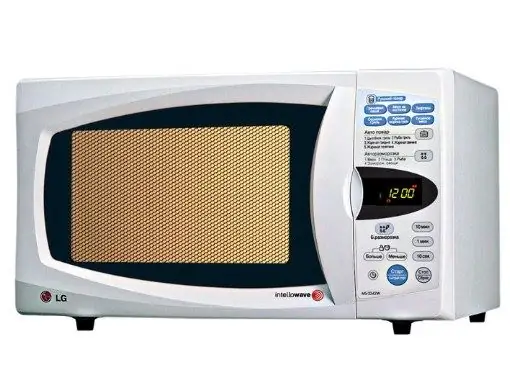- Author Nora Macey [email protected].
- Public 2023-12-16 10:17.
- Last modified 2025-01-23 08:48.
The microwave oven works on the dipole shift principle. The microwaves generated by the magnetron cause the water molecules in food to vibrate. The kinetic energy of the movement of molecules is converted into heat. This is how the food heats up.

A microwave oven is a household electrical appliance designed to heat or cook food using microwave radiation.
Microwave
Microwave radiation includes radio waves of the decimeter, centimeter and millimeter ranges. Microwave ovens familiar to humans use decimeter radiation with a frequency of more than two megahertz.
The main difference between a microwave and, for example, an oven is that the food in it is heated not only from the surface. High-frequency radio waves can penetrate to a depth of 2-3 centimeters, which significantly speeds up the heating or cooking process.
Principle of operation
The principle of operation of microwave ovens is based on a dipole shift. If the material contains polar molecules (for example, water), the energy of radio waves acting on these molecules makes them constantly shift, lining up along the lines of force of the field. The field that affects the object is variable, so the molecules seem to "swing" from one side to the other. At the same time, they transfer the energy received from radio waves to each other.
According to the laws of physics, the temperature of a body is directly proportional to the kinetic energy of the movement of its molecules and atoms. Accordingly, the more actively polar molecules are set in motion, the more the object heats up. This phenomenon is called dipole shift. It is the conversion of electromagnetic radiation into heat.
Since water plays the role of polar molecules in food, modern microwave ovens are designed in such a way as to heat exactly the water molecules, moreover, in a liquid state. Therefore, for example, ice or sugar is heated noticeably slower in the microwave.
The source of radio waves in microwave ovens is a magnetron. A magnetron is a special vacuum tube capable of generating decimeter wavelengths. Waves from the magnetron are transmitted to the inner space of the furnace through waveguides.
The history of the invention of microwave ovens
American military engineer Percy Spencer is considered the inventor of microwave ovens. While Percy was working in the laboratory on radars for the Navy, he noticed that the sandwich placed on the switched on magnetron was heating up.
There is another version of the history of the discovery of microwaves, according to which a bar of chocolate melted in Percy's pocket from the radiation of a magnetron.






